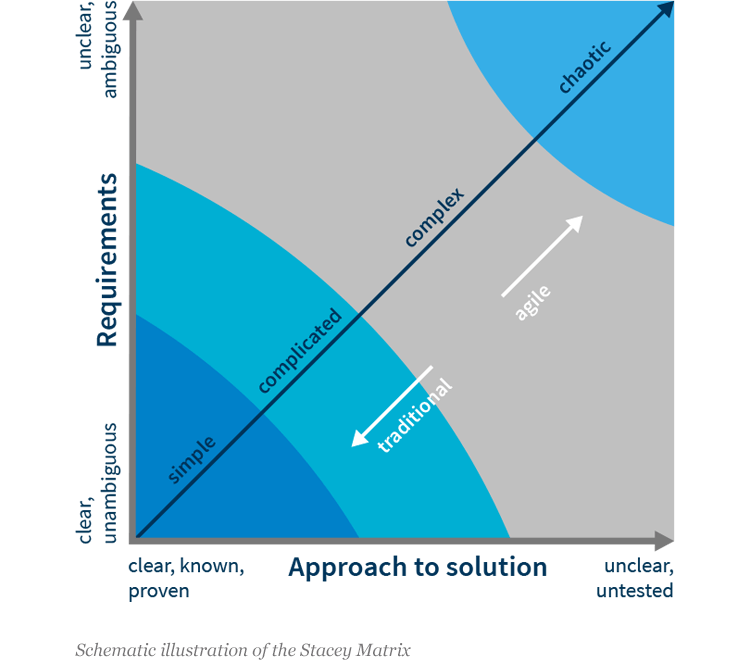Innoflash #99 mit Dorothea Winter
Autor*IN Amy Cotton Veröffentlicht: 16. Dezember 2025 Kategorie Blog , Innoflash Innoflash #99
Or rather, the agile Stacey Matrix.
Combining the original Stacey Matrix with the Cynefin Framework (yes, more buzzwords) is a valuable tool for agile working. You can read the original theories here and here - otherwise it would go too far at this point.
The Stacey Matrix and the resulting environments simple, complicated, complex and chaotic result from the tension between the two dimensions requirement (WHAT) and procedure (HOW):

This results in the dimensions simple, complicated, complex, chaotic. You can now assess the use of agile methods in a meaningful way.
In simple environments, the problem and solution are known and can be solved with a high degree of certainty and predictability. You work with standards, best practices and do what you have always done. You can easily scale and distribute work based on predefined checklists. The use of agile methods is unnecessary and creates more effort than necessary or may even cause a disruption.
Complicated environments are characterized by a high number of variables that nevertheless follow a linear causality. However, since there are too many variables to easily keep track of, you need time and possibly experts for extensive analyses and the development of plans. Agile methods like Kanban can help you organize your work and workflow with the involvement of many people.
Complex environments are characterized by many variables that interact with each other. No matter how much you invest initially, you can’t possibly predict what exactly will happen. That means you can only make assumptions, learn through constant trial and error, and recognize patterns. In such environments, the use of agile methods is mandatory. For example, you can use the Spotify model to align your organization, OKR to synchronize the work of individual teams with business goals, and Scrum to organize the work of one or more teams.
Chaos is not to be avoided per se, then innovation takes place at the border to chaos. This means that the closer you get to chaos, the more you have to rely on very short iteration cycles. Here, procedural agile methods like Scrum almost get in your way more than they help. Here you are dependent on fast action, many experiments and direct feedback. The more uncertain your project, the more important it is to build and test simple prototypes quickly in a design thinking process. As soon as your project is a bit more mature, you can continue working with a Minimum Viable Product and the Lean Startup method.
Lorem ipsum dolor sit amet, consectetur adipiscing elit. Ut elit tellus, luctus nec ullamcorper mattis, pulvinar dapibus leo.
Lorem ipsum dolor sit amet, consectetur adipiscing elit. Ut elit tellus, luctus nec ullamcorper mattis, pulvinar dapibus leo.
Autor*IN Amy Cotton Veröffentlicht: 16. Dezember 2025 Kategorie Blog , Innoflash Innoflash #99
„Wir haben eine tatsächliche Ransomware gebaut – mit verschlüsselten Dateien, Lösegeldfo
Joel erzählt offen, wie er früher alles als Wettbewerb gesehen hat – bis er verstanden hat,
Einmal im Monat liefern wir Euch exklusive Denkanstöße, inspirierende Podcast-Tipps, die besten Prompts aus unserem Team, spannende Veranstaltungshinweise und Klick-Tipps direkt in Euer Postfach. Verpasst keine Impulse mehr für Euren digitalen Erfolg!